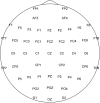Differences in Functional Connectivity between Patients with Depression with and without Nonsuicidal Self-injury
- PMID: 39069684
- PMCID: PMC11289610
- DOI: 10.9758/cpn.23.1133
Differences in Functional Connectivity between Patients with Depression with and without Nonsuicidal Self-injury
Abstract
Objective: : Nonsuicidal self-injury (NSSI), which involves deliberate harm to body tissues without suicidal intent, represents an escalating clinical concern. We used electroencephalography (EEG) to investigate the differences in functional connectivity (FC) patterns in patients with depression with and without a history of NSSI.
Methods: : Seventy-seven patients with mood disorders experiencing major depressive episodes were categorized into NSSI (Group A; n = 31) and non-NSSI (Group B; n = 46) groups on the basis of their NSSI history. EEG data were collected and FC was analyzed using coherence (Coh), imaginary coherence (iCoh), and phase-locking value (PLV) metrics. Network indices based on graph theory were calculated. Demographic and clinical characteristics and scale scores were compared between groups A and B.
Results: : While the two groups showed no significant differences in demographic characteristics such as age and diagnosis, the Beck Depression Inventory and Suicidal Ideation Questionnaire (SIQ) scores were higher in Group A. Binary logistic regression analyses revealed associations of NSSI with sex and the SIQ score. We examined the connectivity of 1,326 pairs of signals across six frequency bands, yielding 7,956 signal pairs. The two groups showed no significant differences in the Coh, iCoh, corrected PLV, or network indices but showed significant differences in all the frequency bands when an uncorrected t test was used.
Conclusion: : In this study, FC differences in depression with and without NSSI were not observed. Further well-controlled research is expected to clarify neurobiological underpinnings and guide future interventions.
Keywords: Depression; Electroencephalography; Functional connectivity; Nonsuicidal self injury.
Conflict of interest statement
No potential conflict of interest relevant to this article was reported.
Figures
Similar articles
-
Disruption of Neural Activity and Functional Connectivity in Adolescents With Major Depressive Disorder Who Engage in Non-suicidal Self-Injury: A Resting-State fMRI Study.Front Psychiatry. 2021 Jun 1;12:571532. doi: 10.3389/fpsyt.2021.571532. eCollection 2021. Front Psychiatry. 2021. PMID: 34140897 Free PMC article.
-
Characteristics of nonsuicidal self-injury associated with suicidal ideation: evidence from a clinical sample of youth.Child Adolesc Psychiatry Ment Health. 2015 Jul 8;9:20. doi: 10.1186/s13034-015-0053-8. eCollection 2015. Child Adolesc Psychiatry Ment Health. 2015. PMID: 26157479 Free PMC article.
-
Psychometric Properties of Korean Version of Nonsuicidal Self-injury Inventory: Validation Study of Deliberate Self-harm Inventory.Clin Psychopharmacol Neurosci. 2024 Nov 30;22(4):669-678. doi: 10.9758/cpn.24.1208. Epub 2024 Aug 27. Clin Psychopharmacol Neurosci. 2024. PMID: 39420614 Free PMC article.
-
Nonsuicidal Self-Injury and Perfectionism: A Systematic Review.Front Psychiatry. 2021 Jul 7;12:691147. doi: 10.3389/fpsyt.2021.691147. eCollection 2021. Front Psychiatry. 2021. PMID: 34305684 Free PMC article.
-
Using the MMPI-2-RF to Assess Risk of Nonsuicidal Self-Injury among College Students.J Pers Assess. 2021 Jul-Aug;103(4):455-464. doi: 10.1080/00223891.2020.1801701. Epub 2020 Aug 12. J Pers Assess. 2021. PMID: 32783548 Review.
Cited by
-
Artificial Intelligence in Psychiatry: A Review of Biological and Behavioral Data Analyses.Diagnostics (Basel). 2025 Feb 11;15(4):434. doi: 10.3390/diagnostics15040434. Diagnostics (Basel). 2025. PMID: 40002587 Free PMC article. Review.
References
LinkOut - more resources
Full Text Sources



